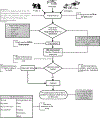Formative assessment and design of a complex clinical decision support tool for pulmonary embolism
- PMID: 26718820
- PMCID: PMC10687829
- DOI: 10.1136/ebmed-2015-110214
Formative assessment and design of a complex clinical decision support tool for pulmonary embolism
Abstract
Electronic health record (EHR)-based clinical decision support (CDS) tools are rolled out with the urgency to meet federal requirements without time for usability testing and refinement of the user interface. As part of a larger project to design, develop and integrate a pulmonary embolism CDS tool for emergency physicians, we conducted a formative assessment to determine providers' level of interest and input on designs and content. This was a study to conduct a formative assessment of emergency medicine (EM) physicians that included focus groups and key informant interviews. The focus of this study was twofold, to determine the general attitude towards CDS tool integration and the ideal integration point into the clinical workflow. To accomplish this, we first approached EM physicians in a focus group, then, during key informant interviews, we presented workflow designs and gave a scenario to help the providers visualise how the CDS tool works. Participants were asked questions regarding the trigger location, trigger words, integration into their workflow, perceived utility and heuristic of the tool. Results from the participants' survey responses to trigger location, perceived utility and efficiency, indicated that the providers felt the tool would be more of a hindrance than an aid. However, some providers commented that they had not had exposure to CDS tools but had used online calculators, and thought the tools would be helpful at the point-of-care if integrated into the EHR. Furthermore, there was a preference for an order entry wireframe. This study highlights several factors to consider when designing CDS tools: (1) formative assessment of EHR functionality and clinical environment workflow, (2) focus groups and key informative interviews to incorporate providers' perceptions of CDS and workflow integration and/or (3) the demonstration of proposed workflows through wireframes to help providers visualise design concepts.
Keywords: EDUCATION & TRAINING (see Medical Education & Training).
Conflict of interest statement
Figures



References
-
- Nikolaou K, Thieme S, Sommer W, et al. Diagnosing pulmonary embolism: new computed tomography applications. J Thorac Imaging 2010;25:151–60. - PubMed
-
- Wells PS, Hirsh J, Anderson DR, et al. Accuracy of clinical assessment of deep-vein thrombosis. Lancet 1995;345:1326–30. - PubMed
-
- McLachlin J, Richards T, Paterson JC. An evaluation of clinical signs in the diagnosis of venous thrombosis. Arch Surg 1962;85:738–44. - PubMed
Publication types
MeSH terms
Grants and funding
LinkOut - more resources
Full Text Sources
Medical
Research Materials
